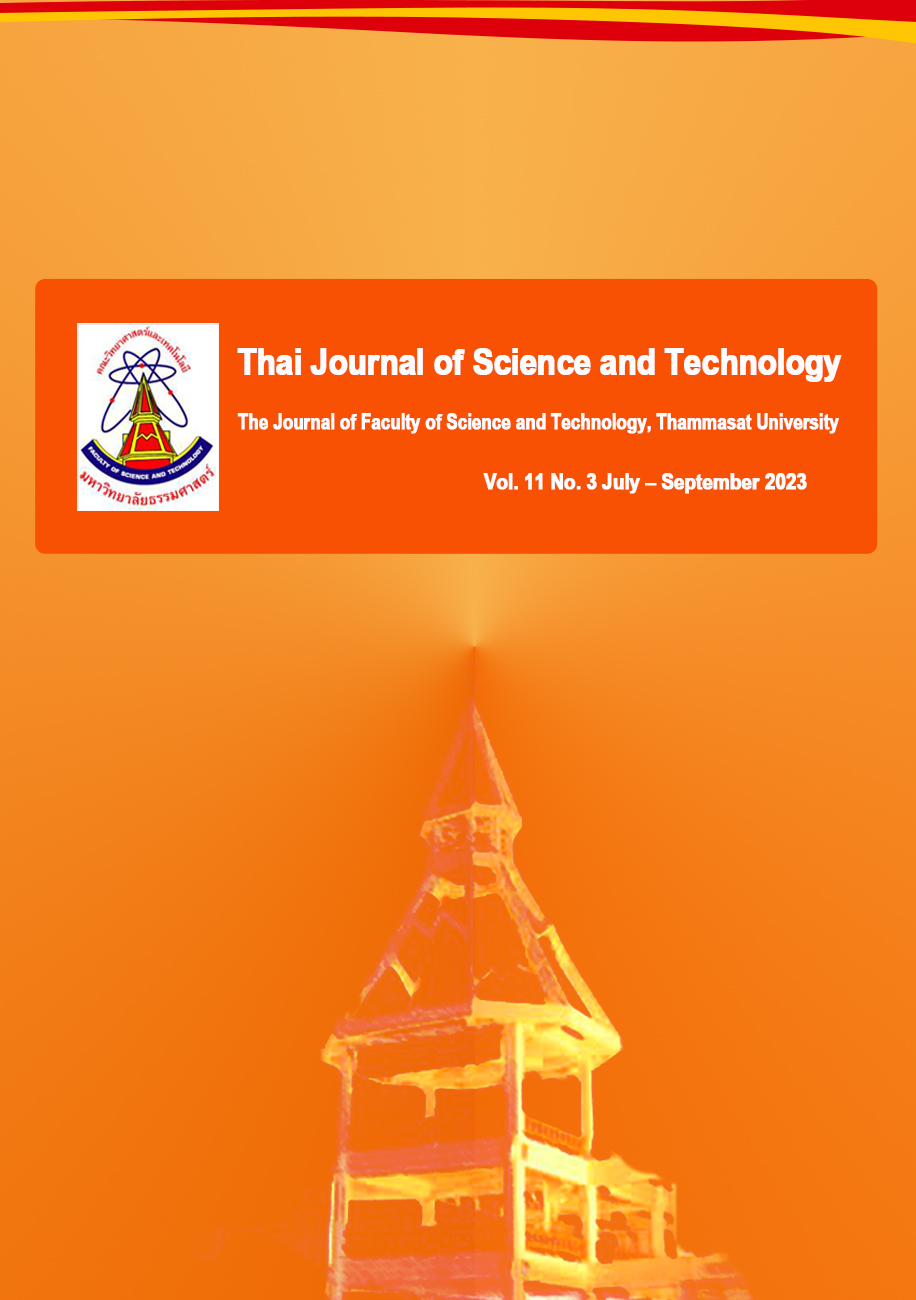Oxyresveratrol Contents in Artocarpus Lakoocha Heartwood and Its Biological Activities
Main Article Content
Abstract
Artocarpus lakoocha heartwood extract initiates a highly robust plant source to become a new natural ingredient for the Thai cosmetic industry. The plant harbors a potential skin-whitening agent namely oxyresveratrol. Five sources of A. lakoocha heartwood powder obtained from the Thai herbal markets were used as test materials. The study focuses on comparing the quality of the different source of plant materials against various solvents used for extraction. The effective extract conditions were evaluated with quantitative correlation analysis of the active substance oxyresveratrol and total phenolic contents in comparison with their biological activities. The 95% ethanol extract and water extract exhibited the highest and lowest content of oxyresveratrol, respectively and correlating with anti-tyrosinase activity while total phenolic content in the extract was correlated with antioxidant activity. Propylene glycol influence on oxyresveratrol content was evaluated to promote the solvent and extraction method to be applied to the Thai cosmetic industry.
Article Details

This work is licensed under a Creative Commons Attribution-NonCommercial-NoDerivatives 4.0 International License.
บทความที่ได้รับการตีพิมพ์เป็นลิขสิทธิ์ของคณะวิทยาศาสตร์และเทคโนโลยี มหาวิทยาลัยธรรมศาสตร์ ข้อความที่ปรากฏในแต่ละเรื่องของวารสารเล่มนี้เป็นเพียงความเห็นส่วนตัวของผู้เขียน ไม่มีความเกี่ยวข้องกับคณะวิทยาศาสตร์และเทคโนโลยี หรือคณาจารย์ท่านอื่นในมหาวิทยาลัยธรรมศาสตร์ ผู้เขียนต้องยืนยันว่าความรับผิดชอบต่อทุกข้อความที่นำเสนอไว้ในบทความของตน หากมีข้อผิดพลาดหรือความไม่ถูกต้องใด ๆ
References
Ahmad, I., Yanuar, A., Mulia, K., & Mun’im, A. (2017). Application of Ionic Liquid as a Green Solvent for Polyphenolics Content Extraction of Peperomia pellucida (L) Kunth Herb. Journal of Young Pharmacists, 9(4), 486-490. doi:10.5530/jyp.2017.9.95
Akinmoladun, A. C., Obuotor, E. M., & Farombi, E. O. (2010). Evaluation of antioxidant and free radical scavenging capacities of some Nigerian indigenous medicinal plants. Journal of Medicinal food, 13(2), 444-451. doi: 10.1089/jmf.2008.0292
AOAC International (2002). AOAC Guidelines for Single Laboratory, Validation of Chemical Methods for Dietary Supplements and Botanicals. Retrieved from https://s27415.pcdn.co/wp-content/uploads/2020/01/64ER20-7/Validation_Methods/d-AOAC_Guidelines_For_Single_Laboratory_Validation_Dietary_Supplements_and_Botanicals.pdf
Batubara, I., Darusman, L., Mitsunaga, T., Rahminiwati, M., & Djauhari, E. (2010). Potency of Indonesian medicinal plants as tyrosinase inhibitor and antioxidant agent. Journal of Biological Sciences, 10(2), 138-144. doi: 10.3923/jbs.2010.138.144
Chatatikun, M., & Chiabchalard, A. (2017). Thai plants with high antioxidant levels, free radical scavenging activity, anti-tyrosinase and anti-collagenase activity. BMC Complementary and Alternative Medicine, 17(1), 487. doi:10.1186/s12906-017-1994-7
Jagtap, U. B., & Bapat, V. A. (2010). Artocarpus: a review of its traditional uses, phytochemistry and pharmacology.Journal of Ethnopharmacology, 129(2), 142-166. doi:10.1016/j.jep.2010. 03.031
Li, X., Wu, X., & Huang, L. (2009). Correlation between antioxidant activities and phenolic contents of radix Angelicae sinensis (Danggui). Molecules, 14(12), 5349-5361. doi:10.3390/molecules14125349
Likhitwitayawuid, K. (2008). Stilbenes with tyrosinase inhibitory activity. Current Science, 94(1), 44–52. Retrieved from http://www.jstor.org/stable/24102028
Palanuvej, C., Issaravanich, S., Tunsaringkarn, T., Rungsiyothin, A., Vipunngeun, N., Ruangrungsi, N., & Likhitwitayawuid, K. (2007). Pharmacognostic Study of Artocarpus lakoocha Heartwood. Journal of Health Research. 21(4), 257-262. Retrieved from https://he01.tci-thaijo.org/index.php/jhealthres/article/view/154186
Que, F., Mao, L., Zhu, C., & Xie, G. (2006). Antioxidant properties of Chinese yellow wine, its concentrate and volatiles. LWT- Food Science and Technology, 39(2),111-117. doi:10.1016/j.lwt.2005.01.001
Singhatong, S., Leelarungrayub, D., & Chaiyasut, C. (2010). Antioxidant and toxicity activities of Artocarpus lakoocha Roxb. heartwood extract. Journal of Medicinal Plants Research, 4(10), 947-953. doi:10.5897/JMPR10.133
Soobrattee, M. A., Neergheen, V. S., Luximon-Ramma, A., Aruoma, O. I., & Bahorun, T. (2005). Phenolics as potential antioxidant therapeutic agents: mechanism and actions. Mutation Research, 579(1-2), 200-213. doi:10.1016/j.mrfmmm.2005.03.023
Teeranachaideekul, V., Nithitanakool, S., Junhunkit, T., Ponpanich, L., Nopporn, N., Detamornrat, U., & Chulasiri, M. (2013). Liposomes: A novel carrier system for Artocarpus lakoocha extract to improve skin whitening. Journal of Asian Association of Schools of Pharmacy, 2, 243-253. Retrieved from https://www.aaspjournal.org/article_html.php? did=5938&issueno=0
Tengamnuay, P., Pengrungruangwong, K., Pheansri, I., & Likhitwitayawuid, K. (2006). Artocarpus lakoocha heartwood extract as a novel cosmetic ingredient: evaluation of the in vitro anti-tyrosinase and in vivo skin whitening activities. International Journal of Cosmetic Science, 28(4), 269-276. doi:10.1111/j.1467-2494.2006.00339.x
Zhou, J., Li, S. X., Wang, W., Guo, X. Y., Lu, X. Y., Yan, X. P., Huang, D., Wei, B. Y., & Cao, L. (2013). Variations in the levels of mulberroside A, oxyresveratrol, and resveratrol in mulberries in different seasons and during growth. The Scientific World Journal, 2013, 1-7. doi:10.1155/2013/380692


